
 So a few weeks back, maybe a month ago now, I started practicing graphic recording tools and techniques in order to bone up for bringing graphic facilitation to my corporate and organizational workshops.
So a few weeks back, maybe a month ago now, I started practicing graphic recording tools and techniques in order to bone up for bringing graphic facilitation to my corporate and organizational workshops.
And because my practice is to share what I’m creating, I posted my efforts on Instagram, which feeds out to Facebook.
I even made a special Pinterest board, just for my Visual Practice stuff.
Now, my gremlins are pretty loud and nasty, so they didn’t hold back telling me all the ways that my “flip chart sketch notes” fell short of what I wanted them to be.
And because I’ve been following all sorts of masters of the field of graphic recording and graphic facilitation, my standards are pretty high, I admit.
So it came as a huge surprise when people started giving me all sorts of positive feedback on what felt to me like pretty feeble efforts.
But hey, it also felt really validating!
Then an interesting thing happened. Not only did I get positive feedback in the form of likes and comments, but some people actually asked if I could make sketchnotes for their business/podcast/whatever, and how much I’d charge.
This really threw me for a loop!
My first reaction was a knee-jerk “No way! I’m not ready! I’m not good enough!”
But then I realized that this was my own fear talking. And if they think my work is good enough to hand over a credit card, then it sure as shootin’ is good enough, no matter what I or my gremlins might think about it.
After all, value is in the eye of the holder of the wallet.
But what was really fascinating was how the mere prospect of doing the same activity for someone else started to change my relationship to the activity.
Commerce has a way of doing that. I’m not saying it has to, but in my experience, money changes things.
In my case, I noticed myself starting to feel rebellious. I didn’t want to pick up my markers so much anymore.
This thing I’d been super excited about, that I couldn’t wait to do each day, was starting to feel like a chore. And I didn’t even have a real client yet!
Extrinsic vs. Intrinsic Motivation
This reminds me of my conversation with Paul McCarthy last week, when we briefly touched on the topic of extrinsic vs. intrinsic motivation.
In his book, Drive: The Surprising Truth About What Motivates Us (aff link – or click here for a non-aff link), Daniel Pink does a deep dive on this subject (it’s well worth a read — super interesting stuff!)
One of the stories I remember about intrinsic vs. extrinsic motivation is a study I first learned about in college, that actually happened in the early 1970s at the Bing Nursery School, the lab school at Stanford University (where my mom was a Head Teacher for over 25 years).
Dr. Mark R. Lepper, Chairman of Stanford’s Psychology Department, designed a series of studies to explore “Intrinsic Motivation, Extrinsic Motivation, and the Process of Learning.”
Here’s an excerpt from bingschool.stanford.edu: (from https://bingschool.stanford.edu/news/mark-lepper-intrinsic-motivation-extrinsic-motivation-and-process-learning):
…Over a three-week period, during the first hour of each class, the teachers put out on one particular table in front of the one-way observation mirrors a new activity—magic markers and drawing paper. Each day, when the children arrived during free play time, this was one of the many choices they had.
From behind the one-way mirror, the researchers could measure how much time during these free play periods each of the children chose to spend with this activity as opposed to others. The participants selected for the study were only those children who showed a high level of interest in the activity—in other words, children who were already intrinsically motivated. [Emphasis mine.]
Then, each of those children was taken into one of the game rooms, where they were asked to engage in the same activity under three different conditions. Under one condition, a reward was offered; the child saw in advance the “Good Player” Award with its line for their name and agreed to draw with the magic markers in order to get it. Under another condition, when the child finished their drawing, they were unexpectedly given a reward. In the third group, children neither expected nor received any tangible reward, but did receive the same feedback on their work as the other children.
Two weeks later, the teachers again put out the magic markers in the classroom. From behind the one-way mirrors, the experimenters observed how much time the children chose to spend with the activity, when there was no longer any tangible reward available.
What happened? The children who had contracted to receive the “Good Player” award showed significantly less interest — in fact, half as much — as they had before the study. So, contracting for a reward to do this initially interesting and attractive activity subsequently had a negative effect on their interest. The misuse of rewards or the use of superfluous awards undermined intrinsic interests, turning an attractive activity into something the child would only want to do if there was a payoff. [Emphasis mine.]
Later studies varied conditions and rewards, but, the same basic effect was always noted — children expecting the reward during the experimental session showed less subsequent interest in the classroom and less interest than they had initially. In a related group of studies, the same effect was found when children had to complete activities under tight time deadlines. And in yet another related study, children’s art teachers were asked to rate the creativity, quality, and interest value of the paintings done during the experiments and found that children who were expecting the reward drew more pictures but of lower average quality. [Emphasis mine.]
This is exactly what I feel happening with me!
And it is exactly what happened with me 20+ years ago, after I fell in love with the art of calligraphy, and then turned it into my business.
Just Because You Can, Doesn’t Mean You Have To, Or Should
A couple of weeks ago, I was on a weekly call with my WAM buddies (WAM stands for Weekly Accountability Meeting). We have been meeting regularly for close to a year now, and these two ladies have been a godsend, helping encourage me onward when I’m feeling low, give me reality checks, and provide much-needed external accountability to get me to follow through on commitments I would otherwise probably let slide, if I were only on the hook to myself.
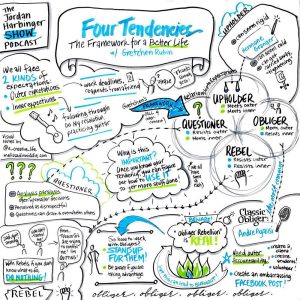 (I am what Gretchen Rubin would call an Obliger, as shown in these Visual Shownotes™ from the Jordan Harbinger show: like most of the population, I tend to meet outer expectations, but resist inner expectations, so external accountability works really well for me.)
(I am what Gretchen Rubin would call an Obliger, as shown in these Visual Shownotes™ from the Jordan Harbinger show: like most of the population, I tend to meet outer expectations, but resist inner expectations, so external accountability works really well for me.)
When I shared my Visual Shownotes™ with my WAM buddies, their enthusiasm was infectious! They had all sorts of ideas for how these graphic creations could be great for my business.
All great ideas.
(Deep breath.)
But.
But what I’ve come to understand in the days since then, as I’ve sadly found myself less and less interested in getting to my flip charts, is that just because I’m hypothetically capable of doing something — or even good at it — doesn’t mean I have to do something.
And here’s the rub: just because I’m hypothetically capable of doing something — or even good at it — doesn’t mean I should do something.
It may seem like a good idea, but is it, really?
The answer to that question is more complicated than it may appear on first reflection.
I’m in another accountability partnership with a friend from my LEGO® SERIOUS PLAY® community, and when we met on Skype last Sunday and I told her about my Visual Shownotes™, she very wisely asked me for three Whys: WHY do Visual Shownotes™? What does doing these Visual Notes™ give me and my business? Here’s what I said:
- They energize me
- They help people process and remember information
- They are a differentiator: they help people differentiate me from competitors
Such a great question! Answering it helped me clarify that doing Visual Shownotes™ for pay, as its own, separate business offering (as opposed to doing them for my own practice, to help me build the skills to bring graphic facilitation into the workshops and trainings I offer through my consultancy), is not going to lead me where I want to go.
It won’t continue to energize me (I’ve already established that doing it for pay, rather than energizing me, is likely to de-motivate me and generate a rebellious response!)
It will help people process and remember information… but only if I can get myself to meet a deadline! And in the meantime, it would eat up my time, and demotivate me.
Better for me to continue to focus on building my skills to add to my facilitators’ toolkit. THAT feels energizing, rather than draining.
Clarity, clarity, clarity.
See how easy it is to get sideswiped, and not understand what the heck is going on?
Back in the late 90s when I started doing calligraphy, being paid to make art seemed like such a dream! It was the Holy Grail to make a living as an artist!
But what you think you want and what you get in reality aren’t always in sync. So it pays to do some deep questioning before going after that dream in earnest.
Me, I tend to dive head-first in the deep end, without testing the water, or even checking to see if the pool has been filled.
This time, though, I’m doing it differently. I’ve learned from past experiences, and as they say, once burned, twice shy.
I don’t want to lose this enthusiastic joyful passion I’ve just discovered. I don’t want to burn out again. So I’m taking things very, very carefully.
I hope my story helps you with whatever you’re working on.
Something Cool
Roasted Cocoa Nibs from Trader Joe’s. $1.99 at a TJs near you. That comes down to $7.96 per pound, which is a pretty good price. From what I’ve read, they’re not the best in terms of flavor or texture, but they’re cheap, and they add a chocolatey crunch that’s free from any sugar or additives — great for topping cereal, yogurt, or what have you.
Enjoy!
Listeners Wanted!
Has the Creative Sandbox Way™ podcast made a difference in your life? Would you like to be featured on the podcast?
I love sharing listener stories, so if you have a story of how listening to the podcast has changed your life for the better in some way — big or small — I want to feature you in a Listener Spotlight.
Here’s how it works:
1. Just log into iTunes and leave a rating and review. (If you don’t know how to do that, you’ll find step-by-step instructions at creativesandboxway.com/itunes-review).
2. Then copy and paste what you wrote in your review into an email, and send it to me, along with why you want to be featured in a Listener Spotlight. How has the podcast made a difference in your life? You can email me at creativesandboxway.com/contact.
That’s it!
If I pick you for a Listener Spotlight, we’ll have a relaxed, fun conversation, and the recording of our conversation will be part of a future episode! How cool is that?
Want a creative kick start?
Check out my book!
What would change for you if you could totally revel in the joy of creating? You CAN, with The Creative Sandbox Way!
You’ll learn:
- Melissa’s 10 fool-proof guideposts that have helped thousands get joyfully creating.
- 5 reasons why creative play is good for you, AND for the world (it’s neuroscience, baby!)
- Why “I’m not creative” is always a lie, and how to bust it.
- How to turn creative blocks into friends.
AND you’ll get creating right in the book itself.
 “It’s one part field guide, one part creative practice—and I loved it. The Creative Sandbox Way is an adventure packaged as a book.”
“It’s one part field guide, one part creative practice—and I loved it. The Creative Sandbox Way is an adventure packaged as a book.”
~Chris Guillebeau
NYT best-selling author of The Happiness of Pursuit and The $100 Startup
Hear ye, hear ye! This is to serve as official notice that all links to anything for sale, be it books or courses, are likely to be affiliate links. What this means is that if you click through said links and make a purchase, although it won’t affect the price that you pay, a few coins will jangle into my coffers, enabling me to buy a packet of hard gluten-free biscuits to feed myself and my husband for another day, or perhaps a pen with which to create some artwork. Or perhaps they will contribute toward paying a fraction of my web hosting bill, so that this blog and podcast can continue to exist. Thank you kindly for your attention.
Thanks for Listening!
Thanks so much for joining me this week. Have some feedback you’d like to share? Leave a note in the comment section below!
If you enjoyed this episode, please share it using the social media buttons you see at the bottom of the post.
Also, please leave an honest review for the Creative Sandbox Way on Tunes!
If you’d also like your voice to be heard on the show, leave your question as a voice message right here.
And finally, don’t forget to subscribe to the show on iTunes to get automatic updates.
Subscribe in iTunes | Subscribe via Stitcher
Now go get creating!

PS — Pssst! Know someone who might benefit from seeing this today? Pass it on!

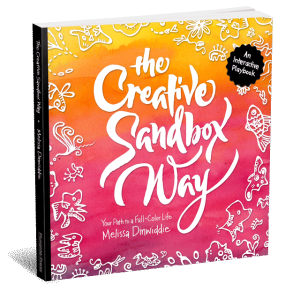

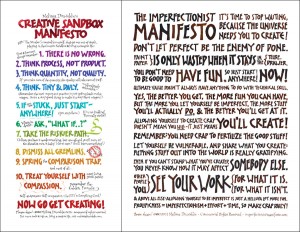 Subscribe to My Newsletter and Get My Manifestos!
Subscribe to My Newsletter and Get My Manifestos!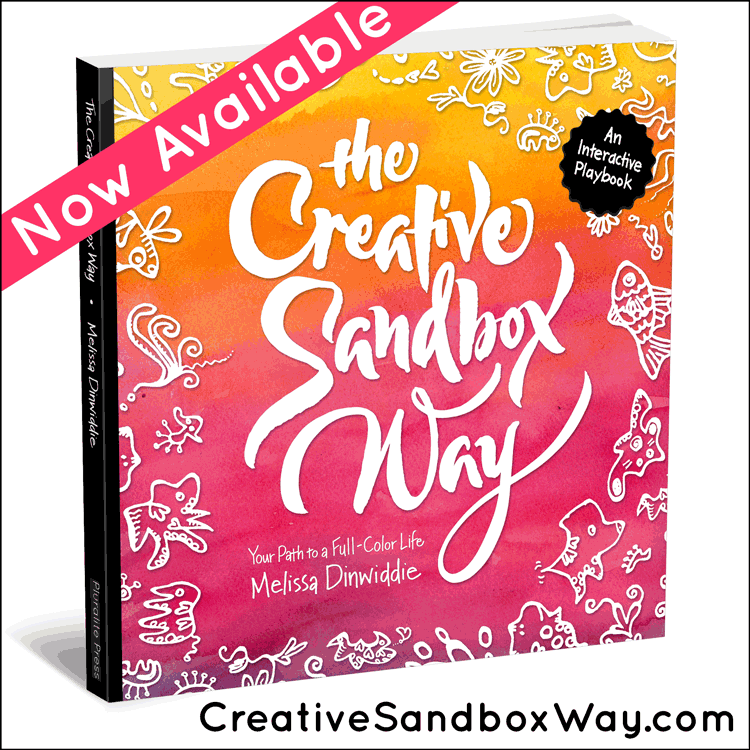
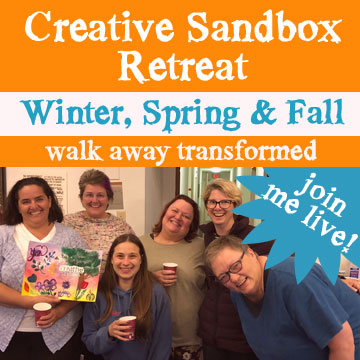
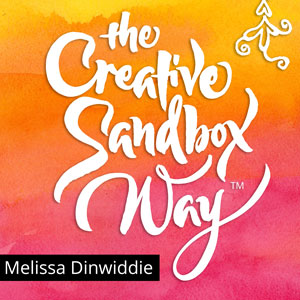

Melissa, this really spoke to me! I feel like I’ve been doing this with my whole life… like you, I dive right in, head first, and always thinking about how it could be monetized.
And just like you, making a living from my art has always been the holy grail. Now that my kids are on the verge of leaving the nest, I can finally get more me time to focus on it. But I am an inveterate experimenter. Not likely conducive to gallery representation. But….
Anyway, I’d like to know how you decided to do what you do instead of selling calligraphy or visual shownotes. What is different about your consulting or community? How did you figure out which passions to monetize?
Ah… It’s been (and continues to be) an ongoing process, Chris! Asking myself what resonates, what nourishes me, what my strengths are, what pays well, and what is the intersection of those things. Paying attention. Following threads. And learning to NOT follow every thread… which has been one of the hardest parts of all!
The journey continues… Onward, ho!
Makes a lot ignored sense! It seems from this post that you followed the energy BEFORE you tested whether it paid well (or you assessed its potential relative to your current offerings). For something like art, it so emotional. It’s hard to give up the idea, the dream, when it doesn’t pay well. For all that time did you still do calligraphy?! Your work is beautiful! I loved the abstract watercolors!
Bingo! Thankfully I’m getting better at looking before I leap as I get older. 😉
And yes, I did calligraphy on commission for about fifteen years, but stopped doing it for myself. I thought it was a matter of not having time, but with hindsight I can see now that there was so much more going on. It was a complicated dance of perfectionist paralysis, the Comparison Trap, and lowered intrinsic motivation, which sucked the joy out of what had been a passion in my life.
A tragedy, really. I don’t ever want that to happen again.
Now I know how essential it is to maintain sacred Creative Sandbox time—time just for yourself, to play and experiment, where commerce and the need to impress others never enters. No matter how creative and fun the stuff you do for work might seem, it’s not the same.
Same here. To be more precise: As soon as I think about money OR deadlines OR others (like commissions), the fun goes and resistance comes, even if I love what I’m doing, and no matter what that is.
A solution that I’m testing at the moment is to look for the joy, and to keep focused on the joy and only the joy until it’s finished. But this old way of thinking is pretty sticky and keeps coming up, so I frequently need to make the conscious decision to reset myself.
As for choosing what to do, I have no solution yet. My interests come round in circles and spirals, and what I’ve learned during the past couple of years is that I don’t want to be stuck on one thing only, but I do need to make temporary choices, like choosing a project or technique for a month or for a week, in addition to things I do regularly/daily (art journal, music, decluttering).
Yes, I think mindfulness helps. It’s a constant dance, isn’t it? And I’m with you—my interests move around. It’s why my Stovetop Model of Life Design is such a lifesaver! https://melissadinwiddie.com/how-your-life-like-stove/
Fantastic! I wonder if you might have a post or podcast intro to your stovetop method?
Yep: https://melissadinwiddie.com/how-your-life-like-stove/
Thank you!
This part really struck a chord, “their desires to continue receiving the newsletter are not more important than my needs to take care of myself, and put my time and energy where my priorities lie.
As a bliss-diverse Creative, the most important thing is to follow your Bliss(es), not do what you’ve always done to please everyone else. That is a sure recipe for burnout!”
Thank you so much for these words to live by! I’ve struggled immensely with that – the marketers’ insistence that one be consistent, cohesive, “trustworthy” (don’t put those newsletters on hold!), and productive – and be a master. I just can’t do that – be that way with 4 or 5 different things all the time. I really appreciate your wisdom, Melissa. I can go against what the marketers say I need to do, in order to maintain my sanity. I just have see if I can maintain a business!
You are so welcome, Chris! It’s hard to learn to set limits, but it absolutely must be done.
And THIS is a lesson I am continually learning myself… 🙂
Yes, you told me about your stovetop method a year or so ago; I think during a webinar. 🙂 At the time I didn’t like it much because my interests were too diverse, and once I chose one I’d stick with it for a rather long time, missing the others. But since the beginning of the year I’ve figured out how to combine and multipurpose them, so I’m free to skip around. Now the method works beautifully, and all my aspects are happy!
PS: I just realised that “skipping around” IS a valid solution – I can stop searching now! 🙂
Yay! YES, it is totally valid!!! I’m glad it was helpful. 🙂